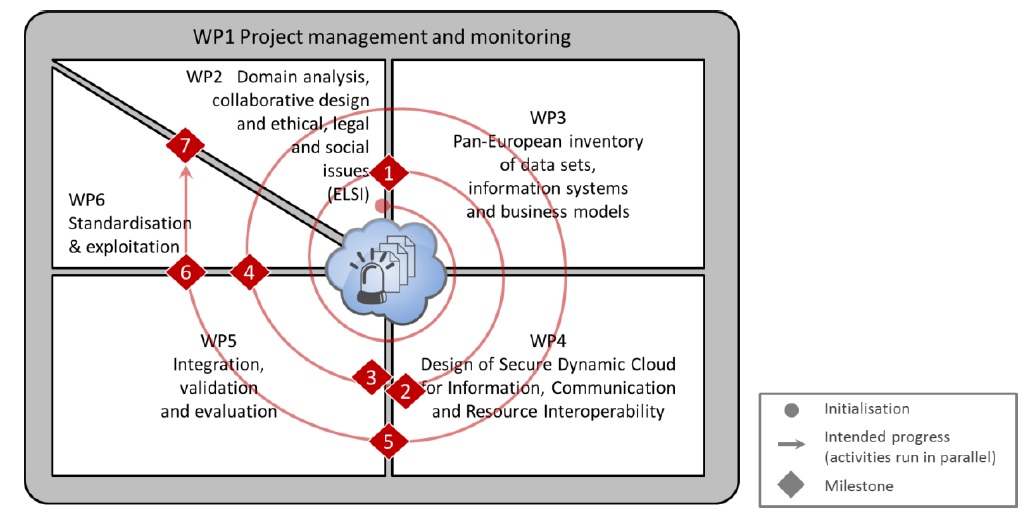Background
Nowadays, the information exchange relies heavily on spoken language or written text. While human-to-human communication is essential for emergency management, support by information technology is not sufficiently utilised due to risks in changing established organisational structures and due to incompatible systems. Content from preparative and post-operational processes is only accessible via intra-organisational channels and systems. When disaster relief forces from different countries co-operate cross-border or internationally, the information management situation is getting even more complicated: On the one hand, heterogeneous languages, organisational structures and responsibilities hinder the information sharing; on the other hand, even if these challenges are met, technical incompatibilities obstruct information sharing between first responders and police authorities from a national and international point of view. Neither a concept for a common knowledge base nor standards for information exchange between all first responders and police authorities have been established so far. Concerning information access and exchange there is no ‘common information space’ providing context based access to structured and unstructured data used for the purpose of security.
SecInCoRe changes this situation. The project identifies processes, information systems and data sets used by first responders and police authorities leading to requirements for a ‘common information space’. While taking account established approaches and carefully addressing existent barriers, a system will be designed complementing the potential of information exchange standards on the one hand and communication network and cloud based technology on the other hand. SecInCoRe will evaluate its results involving all types of stakeholders in complementary operational contexts.
Objectives
In detail the high-level objectives of SecInCoRe are:
Objective 1)
A pan-European inventory of past critical events and disasters and their consequences (especially in terms of time dimension and costs) focused on collaborative emergency operations and real-time decision making. This objective is highly driven by end-users and targeted by empirical research from the perspectives of economics and engineering taking into account ethics, law, psychology and privacy.
Objective 2)
Design of a secure, dynamic cloud based knowledge base and communication system concept including the ability to use emergency information by means of a trans-European communication infrastructure. The consortium follows a design science approach a) to define taxonomy of data sets, standards, processes and information systems and b) to formulate a network enabled communication system concept including effects on business models and new possible emergency as well as crisis management models. Latest technological innovations from information management, service provisioning and communication networks will be integrated.
Objective 3)
Conceptual integration of available technology from the field of information and communication technology into patterns of infrastructure found in first responder organisations. The variety of emergency IT-systems available in Europe and the related variety of information acquisition devices present a new set of challenges to end-users
involved in effective emergency management and law enforcement.
Objective 4)
Evaluation and validation of all results in representative fields of application. A developed, adapted or already in use system will be used for validation in the project scope. The inventory will be used for SecInCoRe system conception and as a database for cooperative disaster management. As a conclusion, extensions to existing crisis management models and modifications to business models of first responder and Police authorities will be proposed.
Workplan

The strategy to implement the SecInCoRe concept transfers S/T objectives and the
intended progress beyond the state-of-the-art to interconnected tasks and work packages:
- End-user community inherent actions: WP2 complements end-user activities and workshops
by research on ethical, legal and social issues (ELSI) and the evaluation of possible effects of
SecInCoRe concepts; Lancaster University as a WP leader ensures high quality human-centred research. - Multi-level pan-European inventory: WP3 builds on representative incidents (see WP2) and
performs research on data and processes, information systems and business
models. The University of Paderborn as a WP leader brings in background knowledge and coordinates activities. - Solution oriented design of a ‘common information space’ concept (complementing usercentred and demand oriented research): WP4 transfers results to a holistic system concept. The TU Dortmund as a WP leader coordinates partners from industry and academia.
SecInCoRe intends to transfer new knowledge to a distinct new capability in terms of FP7 Security.Therefore two elements are added being included in SecInCoRe’s high level objectives:
- WP5 subsumes the implementation, the application to use cases, the validation towards requirements and the evaluation towards the expected impact incl. community building. T6 Ecosystems (WP leader) observes the integration and coordinates the evaluation from this position.
- WP6 highlights standardisation, dissemination and exploitation targeting core cross-cutting objectives of FP7 Security (in co-operation with WP2). Airbus DS as a WP leader ensures powerful actions from the perspective of technology drivers.
SecInCoRe provides benefits to stakeholders early, continuously and in short intervals. Dissemination as well as community building efforts are inherent to Research and Technological Development (RTD) tasks. Therefore, milestones are defined based on the logical interdependencies and temporal constraints. The project runs all RTD work packages in parallel; nevertheless three iterations of all WPs can be highlighted extending the quality and availability of knowledge.
FP7 Topic
If you would like to inform yourself about the EU-Program this project is located in, please follow this link







